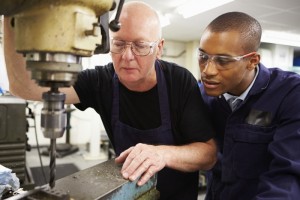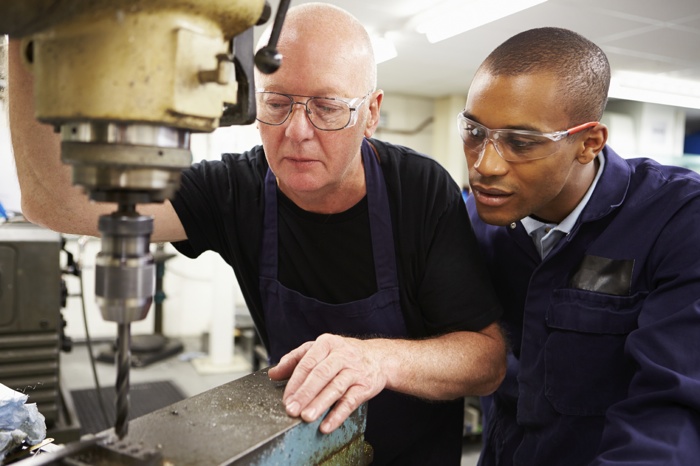
No, this isn’t an adventure story about great works of art or even our national monuments – it’s even more dramatic. I’m referring to the GREAT ones: the machinists we all know who have been around far longer than these fancy new CNC machines. I’m talking about the true craftsmen that built this industry long before many of you were born. Men and women who know how to use the equipment available as well as their hands and brains to get the job done. Those who are, sadly, leaving this world and, unfortunately, the industry much too rapidly.
True American craftsmen are retiring at an alarming rate.
Just as exhaust leaving a combustion chamber creates a negative pressure that is then fed by a fuel-charged intake, there seems to be a great vacuum being created as we lose our true craftsmen and replace them with parts installers. Please don’t take this as criticism of the vast majority of great and qualified machinists out there servicing the public everyday, but being able to do the job is not the same as being able to see that there is more than one way to do it. By crafting a means to an end based on knowledge, experience and confidence things get done. Sadly, craftsmanship is just not a term we use much today.
We’re extremely lucky we had the generation of men and women who knew wrong from right and were not afraid to roll up their sleeves and do whatever was necessary to fight tyranny. Reflecting on the recent VE Day and Memorial Day, I can’t help but compare the loss of our “Greatest Generation” to the continuous and inevitable loss of the great machinists, some of them mechanical geniuses of a time gone by. I’ve been extremely lucky and honored in my 40+ years in the automotive industry to have met and done business with many of them.
One way to recognize true craftsmen might be in the complex questions they ask and the way they are stated. Questions like “How?” You know it’s not directed at you, but more to themselves, as in “which of these ideas will I choose?” Or maybe, “When?” Because in their minds, the job is already done, they just need to know the time frame you’re thinking of coming back to pick it up. “What?” always comes up, because what you’re going to do with their finished work is important for the pride they have in their workmanship.
Today’s popular “Why?” is left out, because if you have to answer that, maybe they’re not right for the job.
We all started out working for someone who inspired us enough to stay on, learn and grow in our newly chosen profession. In 1974, I was working in an independent parts store known for its machine shop. Unlike today, it was the shop that carried the store, not a store that offered some machine shop services.
The variety of engines and jobs that went through those doors was staggering. We just didn’t say no. Parts were not as readily available as they are today so I learned to use the size information in the backs of the books to find a part that roughly met our needs, knowing we had skill in the shop to make the parts fit.
I’ve been impacted by this “can do” attitude since then. On any given day I might see or hear both sides of the spectrum and as time goes by I see it replaced by a “why is that?” attitude.
The level of quality is also what is putting us out of business. We work today in a very precise, close tolerance world. Engines are truly outlasting cars and trucks today, taking away many opportunities we used to have to rebuild an engine halfway through its life.
In the performance world, we have access to more parts of all manner of price and quality than ever. But it is still a world of modification and this is where I see the difference in the old generation versus some of the new. In the old days, craftsmen created performance engines. You didn’t just crack a catalog and pick up the phone to get the parts you need. You either built your own, or modified something else to fit and do a better job. You ‘crafted’ a performance engine.
This was why those hot rodding magazines came into existence. Not driven by advertising and articles that showcased specific manufacturer’s products, but by articles showcasing the meticulous work done by these mechanical wizards. Lucky for us the names of several of these great craftsmen are on the performance products we sell today. These parts were often dreamed up in a time when it was the norm to have to modify things to make them work.
It’s interesting to see the crossover in the shops that will rebuild vintage engines and do performance engine building. The early American “Hot Rodding” attitude, the “can do” spirit that sees a person through a tough build, gets a job done, creates happy customers and many referrals, is found here. I love to go into these shops and hear about their projects. These are the places you find specialty tools, usually built in-house, that were job specific as a means to an end. Engineering happens here. These shops may not have a fancy CNC machine and use an old lathe and a milling machine as often as their boring bars.
That’s the part that’s going away and I think we need to stop for a second to realize our own shortcomings and ask, “Where will the knowledge and expertise come from to replace this aging and fading group?”
For many of us there’s no better way to learn than from someone who’s been there, done that and still has the holey old T-shirt. Books and websites are great for reading, but reading doesn’t compare to experience. That’s the difference, the part that will be missing.
A true craftsman knows his machines. He or she knows the sounds, the way it feels and the way the chips are coming off. When the chips don’t look right, they sharpen their own bits, they don’t just order new ones. And when the situation calls for it, a true craftsman can change bit angles and cutting widths as required.
Times are changing and the requirements for a machinist are changing with them. We must adjust to the new jobs, tooling demands, tolerances and needs of a new breed of customer, but we must not totally lose all of the old ways.
Today, with the restoration market being as strong as it is, we may find ourselves in need of a seasoned vet who worked on the old job then, and can help you with the one you’re trying to save now. Or the job in front of you might require tooling that is just not available when you need it. Or you might just find yourself tackling something you’ve never tried before. The ones to turn to are still out there, but we best appreciate them now.
Let’s face it, there will come a time when your mentor or your go-to guy has hung up his mics and is just not available. Better to recognize that now, learn what we can from what they’ll share, and most of all learn their traits and appreciate their confidence and skills.
Remember, at one time they were just like you, and they too had craftsmen they looked up to for advice and knowledge. If you can recognize and appreciate these skills in others, then there is a really good chance you can find them in yourself and one day be that same inspiration for someone else. n
Special thanks to Chuck, Clark, Duane, Ernie, Gary, Gene, Mike, Randy, Tim, Tom and Larry for inspiring me to do better.














